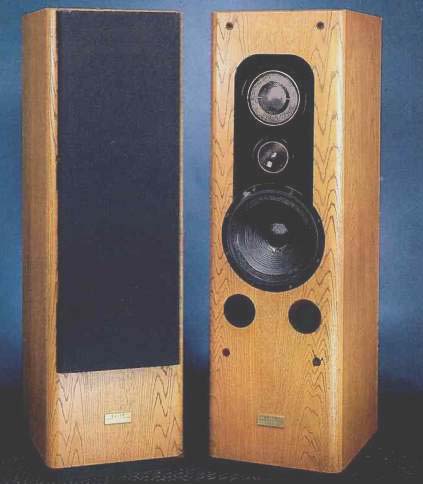
Manufacturer's Specifications:
System Type: Bass reflex.
Drivers: Two 10-in. (25.4-cm) woofers; 2.56-in. (65-cm) dome mid range; 1-in. (2.5-cm) dome tweeter.
Crossover Frequencies: 600 and 4,000 Hz.
Frequency Range: 20 Hz to 40 kHz.
Sensitivity: 91 dB SPL at 1 meter for 2.83 V input.
Nominal Impedance: 4 ohms.
Power Handling: 60 watts nominal, 300 watts maximum.
Dimensions: 48.6 in. H x 14.6 in. W x 20.1 in. D (123.4 cm x 37.1 cm x 51.1 cm).
Weight: 143.3 lbs. (65 kg).
Price: $4,000 per pair.
Company Address: P.O. Box 1540, Long Beach, Cal. 90801.
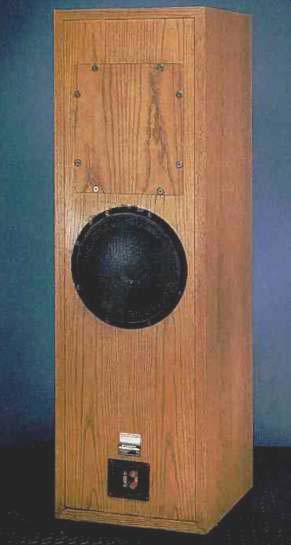
The TZ-9 is Pioneer's flagship loudspeaker system in its Elite series of audio/video components. Key specifications of the TZ-9 are: 143.3 pounds each, 48 5/8 inches high, and $4,000 per pair. A little less of everything is available for $1,800 per pair in the TZ-7. Three new "ST" models in Pioneer's regular line incorporate as much of the "TZ" technology as Pioneer can translate to a lower price.
Pioneer has priced the TZ-9 against some formidable competition from Apogee, B & W, Infinity, KEF. Mirage, Quad, and Vandersteen, just to name a few examples. Also, for far less money, there are large and highly regarded floor-standing systems from AR, Klipsch, Polk, Thiel, VMPS, and others. Note also that all of the competitors I've listed are non-Japanese manufacturers. For whatever reason, North American audiophiles have not generally accepted Japanese high-end loudspeakers' as fully as they have accepted Japanese electronic components. So, what makes Pioneer think they have a shot at the high-end U.S. speaker market? Read on.
First, the TZ-9 is an American speaker. It was conceived, designed, and voiced out of Pioneer's Long Beach, Cal. facility, with drive units and technical development coming from Japan. The TZ-9 is manufactured in the U.S. and sold only in North America by fewer than 200 select high-end retailers. You won't find appliance-store " midnight madness" sales blowing TZ-9s out the door at half price, and you won't find the TZ-9 in Tokyo.
The second reason for Pioneer's confidence is the size, experience, and technology of the parent company. A loud speaker named "Pioneer" was the first product of Fukuin Denki Kabushiki Kaisha, founded by Nozomu Matsumoto in 1938. The company was renamed Pioneer in 1961 and grew quickly as a result of its innovations in car stereo, home electronics, loudspeakers, and the LaserDisc. A major re source currently is the speaker design team that designed the TAD professional loudspeakers. These drive units are widely considered to be the best available for high-level sound applications. In summary, Pioneer is larger and older than any of the competitors mentioned above.
The final reason to take the TZ-9 seriously is the advanced technology incorporated into it. A special process is used to form pure carbon into ceramic graphite domes for midrange and tweeter. Pioneer has found this brittle material to have mechanical characteristics superior to such exotic dome materials as titanium, carbon fiber, beryllium, boron alloy, carbon graphite, and ceramic carbon. Incidentally, most of these materials were first developed for loudspeakers by Pioneer.
The midrange dome and tweeter below it are mounted on a thick subpanel separated from the front baffle board by an isolating layer of foam. However, I question the extent of the isolation because the driver-mounting bolts extend through the foam, rigidly coupling the two panels. The crossover components are mounted on another subpanel in a similar manner. Input to the high- and low-frequency sections of the crossover are available separately for biamping. Four heavy-duty, gold-plated, five-way binding posts are normally strapped to accept a single speaker cable to each cabinet. There are no provisions for making level or equalization adjustments.
Two woofers, one on the front and one on the rear, are used in the TZ-9 to cancel reaction forces from cone acceleration. This reduces cabinet vibration and radiation of the panel walls. While the cabinet walls themselves could provide the mechanical coupling between the woofers, the TZ-9 goes a step further by internally connecting the speaker magnets with a steel rod. To my knowledge, KEF was the first to use this technique, in the Model 104. KEF also physically reversed one woofer (maintaining acoustic polarity) to cancel some motor nonlinearities as well.
Computer simulations, computer-based instrumentation, and Doppler laser techniques were used extensively by the Japanese engineers to design the enclosure. The design is covered in a paper delivered at the AES 85th Convention in November 1988 (Preprint No. 2739), "A New Loudspeaker System with Reduced Radiation of Sound Pressure from Parasitic Enclosure Vibration," by Takashi Oyaba. Extensive mechanical, electrical, and acoustical measurements are also presented in a 41-page paper from Pioneer.
The result of all this is the TZ-9: Big, heavy, and expensive. Big means that you can get clean, deep bass response with good efficiency (although this speaker has a fairly small footprint). Heavy buys you thick enclosure walls, damping panels, and cast speaker frames. Expensive gets you the high-tech ceramic carbon domes (each protected by a wire mesh), precision, intricate construction, and a beautiful oak veneer. None of this guarantees great sound, but why start with compromises?
Measurements
Figure 1 plots the input impedance magnitude of the TZ-9.
A minimum of just about 4 ohms is reached at the cabinet resonance frequency of almost exactly 30 Hz. Both the magnitude and the complex impedance plot, Fig. 2, show a glitch at 280 Hz.
Anechoic frequency response of the TZ-9 was measured at a distance of 1 meter along a line from the acoustic center of the system to a seated listener 3 meters away and 1 meter high. Various measurement techniques were used to get high-frequency resolution at all frequencies without room reflections. The amplitude response of the first-arriving signal is plotted in Fig. 3. Except for a jump at 280 Hz, the response is very uniform, varying only about ±2 dB from below 40 Hz to the end of the measurement at 20 kHz. The low end is solid to 30 Hz, with a fast roll-off-typical of vented designs-below that. Sensitivity for 1 watt input is about 88 dB SPL, which confirms Pioneer's claim of 91 dB SPL with 2 watts input.
The amplitude glitch at 280 Hz puzzled me, and I traced it to a simple, internal standing wave between the top and the bottom of the cabinet. I first calculated its possible existence by dividing the 13,548 inches/S speed of sound by the 46-inch internal height of the TZ-9; this gives the frequency of a 46-inch wavelength. At this frequency (296 Hz calculated, close enough to the measured frequency), the center-mounted woofers activate the second top-to-bottom resonance mode. The standing-wave theory was confirmed by sound pressure measurements made inside the loud speaker's cabinet.
Inside the cabinet, at 280 Hz, the woofer cones have to work against the pressure wave they generated half a cycle earlier. This acoustic loading restricts woofer cone motion and delivers more power to the inside of the cabinet, which results in wall flex. From the outside of the cabinet, the reduced cone motion at 280 Hz means reduced sound radiated by the cones, and this combines with the out-of-phase cabinet-flex radiation to produce a sharp dip. Above this frequency, the air column goes off resonance and the phase shifts rapidly to produce a slight reinforcement.
Phase response was measured along with the amplitude response and is plotted in Fig. 4. Any phase shift caused by the acoustic resonance must be small, because no corresponding glitch is visible on the down-sloping plot of the TZ-9.
The majority of this phase shift is produced by the conventional frequency-dividing networks necessary in a multi-way system. Most loudspeaker system designers do not consider it to be an audible problem if the two stereo speakers are identical, and I found unusually close tracking of the phase responses of my review pair.
Figure 5 plots the TZ-9s' amplitude response modified by early reflections in a room. The speaker positions used were those found to be optimum in the earlier listening evaluation, well out from the rear and side walls and rotated inward. The 0° plot was made at the listening position, and the 30° plot was made close to the side wall near the speaker. Reflections in this range can produce coloration to the sound, imaging instability, and-most believe-suppression of recorded ambience information. The TZ-9 performs well, keeping peaks and dips narrow and constrained to about ±6 dB. The usual floor-bounce cancellation around 300 Hz is thankfully missing. Perhaps this is due to the rear-firing woofer. The 30° off-axis, in-room performance is even better than the on-axis, it-room response of this speaker.
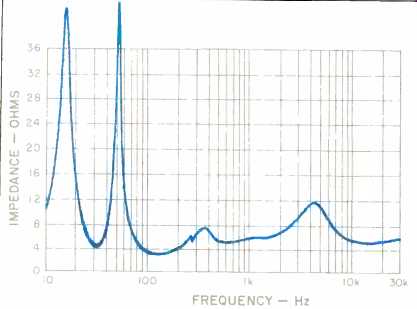
Fig. 1--Magnitude of impedance.

Fig. 2--Complex impedance.
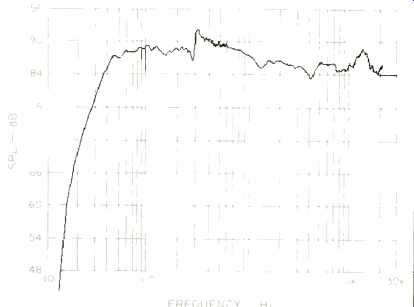
Fig. 3--One-meter, on-axis anechoic frequency response, with an input of 1.0
watt into 4 ohms (2.0 V).

Fig. 4--One-meter, on-axis anechoic phase response.
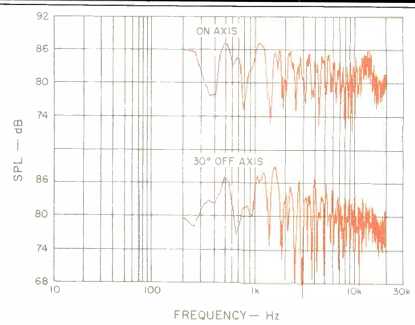
Fig. 5--Three-meter room response measured on axis and 30° off axis; for clarity,
off-axis curve has been lowered.
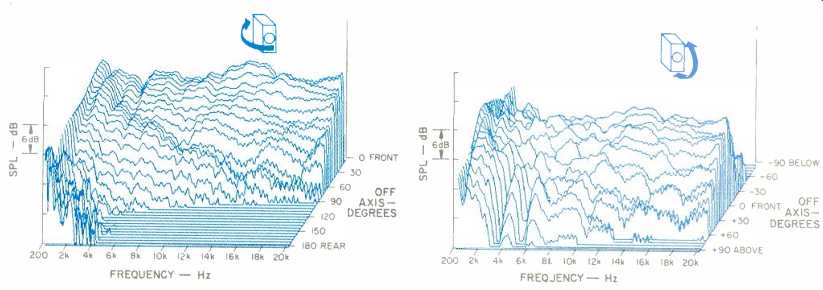
Fig. 6--Horizontal off-axis polar response taken from the front, around the
side, and to the rear of the speaker.
Fig. 7--Vertical off-axis polar response taken from below, up the front, to the top of the speaker.

Fig. 8-Harmonic distortion products for the tone E1 (41.2 Hz).
Fig. 9-Harmonic distortion products for the tone A2 (110 Hz).
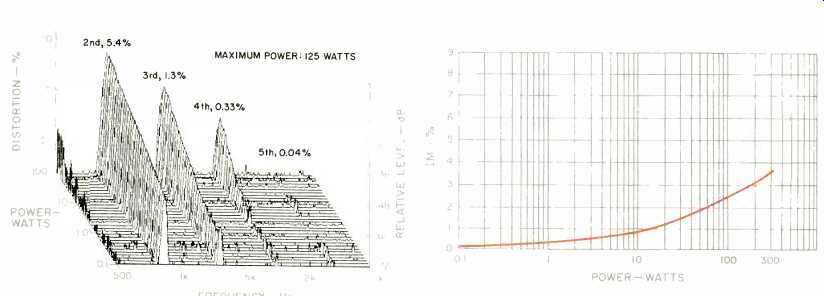
Fig. 10-Harmonic distortion products for the tone A4 (440 Hz).
Fig. 11--IM distortion on 440 Hz (A4) produced by 41.2 Hz (E1) when mixed in one-to-one proportion.
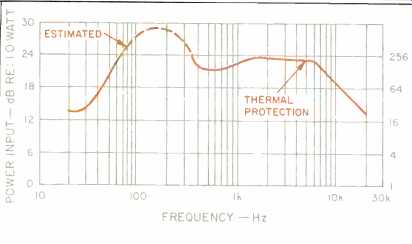
Fig. 12--Power linearity.

Fig. 13--One-meter, on-axis energy-time response.
Horizontal polar amplitude response was measured every 3°, starting behind the TZ-9, coming around the side, and finishing directly on axis; results are plotted on a linear frequency scale in Fig. 6. We see nearly ideal behavior in the gradual narrowing of the radiation angle at high frequencies. Thanks to well-chosen crossover frequencies, there is none of the alternating narrow and wide behavior found in most two-way, and some three-way, speaker systems. The presence of ranges of narrow directivity implies that less energy is radiated into the room in these ranges; the result would be corresponding imbalances in the reverberant energy heard by the listener. The Pioneer TZ-9, however, can be expected to sound great in a balanced, lively room that has good diffusion.
A similar "3-D" display of vertical polar radiation is shown in Fig. 7. The curves were measured from below, up the front, to directly above the cabinet. Since each change in measurement angle also results in a change in distance from the vertically aligned drivers, there is interaction around the midrange-tweeter crossover frequency of 4 kHz.
The amount shown is fairly small and occurs only at angles well off axis. Otherwise, the excellent, wide directivity found in the horizontal plane is maintained here as well. The wide overall directivity suggests that the TZ-9s be kept well away from side walls and overhangs to avoid early reflections.
Harmonic distortion products are shown as a function of drive level in the "3-D" plots of Figs. 8, 9, and 10 for input frequencies of 41.2 Hz, 110 Hz, and 440 Hz. For reference, the open E string on a string bass sounds at 41.2 Hz, while the other two frequencies are musical notes as well, A2 and 04 (middle C). This E note is an easy frequency for the TZ-9, because it is above the box resonance frequency and most of the sound is radiated by the ports. Indeed, the highest distortion product, the second harmonic, is a mere 2.1% at 125 watts input. However, note the additional nonharmonic noise that rises at power inputs above 10 watts. This is a "chuffing" sound from air rushing in and out of the ports at high velocity. This noise is very audible on sine waves and can be heard on certain music passages (try Saint-Satins' Organ Symphony adagio section on Philips 412-619-2). This "port-noise complaint" was never audible on percussion or on music having upper range instruments playing to mask the noise. One design cure for this problem is to use a larger port diameter or a more aerodynamic port configuration.
Using a rear or down-firing port helps as well, by dispersing the noise.
Distortion at 110 Hz is an almost nonexistent 0.5% at maximum power. At 440 Hz, distortion is up somewhat because the midrange dome is just crossing in and is working hard. At higher frequencies, I expect distortion would go down again. All in all, the TZ-9 is a remarkably distortion-free speaker except for the chuffing low bass.
Another way of looking at low-frequency linearity is to measure a low-frequency sine wave's effect on a simultaneous higher frequency signal. Figure 11 shows the modulation of 440 Hz by 41.2 Hz (middle C by E1) versus total input power. (Technically, the power calibration is that of a sine wave with the same peak voltage as the combined test signals. This is the same calibration method used for testing power amplifiers.) Again, the TZ-9 shows very linear behavior, which justifies the use of a high-power amplifier if you want very high sound pressure levels.
Power linearity, plotted in Fig. 12, is a full-range test of power handling. The plot shows the power input which causes a 1-dB compression of the acoustic output. Compression can be due to port turbulence, voice-coil heating, or nonlinear distortion. Power levels above the 1-dB compression level produce more mush than fidelity. The TZ-9 handles 100 watts or more over most of its range. Little of its observed compression was due to nonlinear waveform distortion, so the TZ-9, could be expected to handle very high power inputs on musical peaks without sounds of distress.
Energy versus time is plotted in Fig. 13. A perfect speaker would show a single spike, indicating that signals of all frequencies arrive at the same time and that there are no reflections or edge diffractions. The TZ-9 comes very close to this ideal.
Use and Listening Tests
The large size and heavy weight of the Pioneer TZ-9s make planning an important part of experimenting with them. For instance, to unpack them you need an 8-foot-plus ceiling to lift the box off easily. After unpacking, I used a small padded hand truck to move them around for best imaging. Once in place, the TZ-9s tend to blend in nicely because of their tall, slim shape and light, attractive finish.
Most users will not have many placement options for speakers of this size. Fortunately, I found the imaging and spectral balance to be relatively insensitive to location. At first, I used them well out from the wall behind, and about 8 feet apart, with very good results. As I became accustomed to these speakers' superior power output, I opted for a more distant placement, close to the wall behind them and further apart. I angled them inward to reduce early, side-wall reflections and achieved a wide area of listenable stereo, although listening on the equidistance center line was still the best position.
Listening to the CD Lyle Lovett and His Large Band (Curb MCAD-42263), I began to realize that I don't always play this disc loudly enough on other speakers. This is brass and percussion recorded with a close-up perspective, which translates to loud. As I increased the volume to truly live levels, the TZ-9s responded, producing a big, airy sound stage with no sense of strain. They seemed to take command of room acoustics, rather than interact with them.
Other music auditioned included Jennifer Warnes' Famous Blue Raincoat ( Cypress 661 111-2). The music was open and bright with a hint of an electronic sound to the reverberation. I think this is an indication of the TZ-9s' accuracy, because electronic reverb was undoubtedly used to make the recording. However, Jennifer's voice was apparently split at times, seeming to come from both speakers, rather than locking in naturally at a single perceived location between the speakers. Also, low, mid, and high components of the voice did not blend seamlessly in depth perspective. In particular, a tendency for low-mids to come forward in the soundstage was noted. Perhaps this was an audible effect of the 280-Hz internal resonance found in the measurements.
As usual, I listened extensively to these speakers before making measurements, but nowhere in my notes did I say, ". . upper bass resonance-check it out." I did comment on extra warmth and the subtle depth-imaging shift on cello and on Warnes' voice. This resonance is at most a minor sonic issue and could probably be eliminated with addition al internal layers of acoustic absorption material one-quarter and three-quarters of the way up the cabinet, where the particle velocity of this resonance is at its maximum.
All-out acoustic power of the TZ-9s was tested with "The Race" from the Flag CD by the group Yello (Mercury 836426-2). This is rubber-room music at its finest. Clean, chest-thumping volume and sense of space were excellent.
I did notice that the information around 20 Hz, normally audible with large subwoofers, was not present. To the TZ-9s' credit, this extreme signal condition did not cause its woofers any distress; they just ignored it. Overall, the TZ-9s excel in presenting an airy sense of space with either delicacy or power, as the music demands.
In relation to its many high-end competitors, I'd say the Pioneer TZ-9 is in the running, though it doesn't blow the others away. For example, a competitive loudspeaker may respond all the way to 20 Hz but may not develop the clean, high sound pressure levels above 30 Hz that the TZ-9 did.
Another may have pinpoint imaging at a stereo sweet spot but demand unpleasantly dead room acoustics. It's a buyer's market; at $4,000 per pair, there are many great loud speakers available. For good looks, noncritical placement of speaker or listener, and an airy, powerful, clean sound, check out Pioneer's TZ-9.
-David L. Clark
=================
(Audio magazine, Jun. 1990)
Also see:
Pioneer CS-E400 Speaker System (Aug. 1972)
Pioneer CSR 300 speaker (Feb. 1973)
Pioneer F-90 Tuner (Jan. 1984)
Precise Monitor 10 Speaker (Sept. 1990)
= = = =